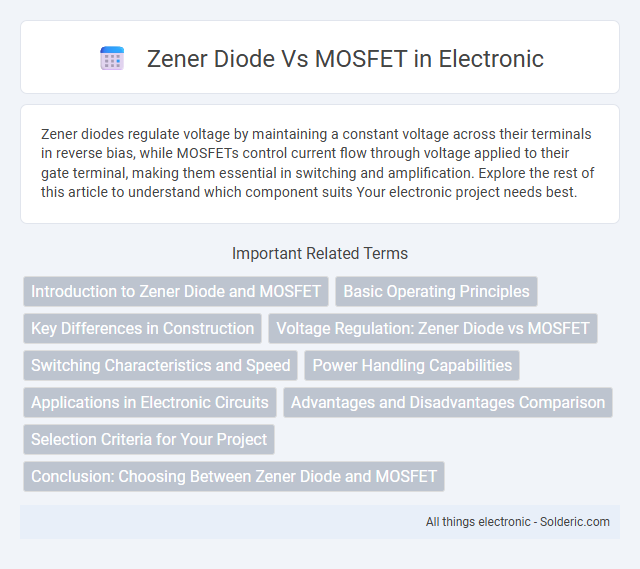Zener diodes regulate voltage by maintaining a constant voltage across their terminals in reverse bias, while MOSFETs control current flow through voltage applied to their gate terminal, making them essential in switching and amplification. Explore the rest of this article to understand which component suits Your electronic project needs best.
Comparison Table
| Feature | Zener Diode | MOSFET |
|---|---|---|
| Type | Semiconductor diode | Metal-Oxide-Semiconductor Field-Effect Transistor |
| Function | Voltage regulation and voltage reference | Switching and amplification |
| Operation | Breakdown at a specific voltage (Zener voltage) | Controlled by gate voltage to modulate current |
| Applications | Voltage stabilizers, surge protectors, voltage clamps | Switches, amplifiers, power control circuits |
| Control | Passive device, no external control | Active device, requires gate voltage control |
| Power Handling | Low to moderate power | Low to high power depending on MOSFET type |
| Speed | Fast response to voltage changes | Very fast switching speed |
| Symbol | Diode with bent line representing breakdown | Three-terminal device: gate, drain, source |
Introduction to Zener Diode and MOSFET
A Zener diode is a semiconductor device designed to allow current to flow in the reverse direction when a specific breakdown voltage is reached, providing voltage regulation and protection in circuits. A MOSFET (Metal-Oxide-Semiconductor Field-Effect Transistor) controls the flow of electrical current using an electric field, widely used for switching and amplification purposes in electronic devices. Your choice between these components depends on whether voltage stabilization (Zener diode) or efficient switching and amplification (MOSFET) is required for your application.
Basic Operating Principles
Zener diodes regulate voltage by allowing current to flow in the reverse direction when a specific breakdown voltage is reached, providing voltage stabilization in circuits. MOSFETs control current flow through an electric field applied to the gate terminal, acting as efficient switches or amplifiers in digital and analog applications. Your choice between a Zener diode and a MOSFET depends on whether you need voltage regulation or precise control of current flow.
Key Differences in Construction
Zener diodes are constructed using heavily doped p-n junctions designed to allow current to flow in the reverse direction when a specific breakdown voltage is reached, enabling voltage regulation. MOSFETs feature a three-terminal structure with a gate, source, and drain, utilizing a metal-oxide-semiconductor capacitor to control current flow through an insulated gate. The distinct semiconductor material arrangement and terminal configuration result in fundamentally different electrical characteristics and applications.
Voltage Regulation: Zener Diode vs MOSFET
Zener diodes provide voltage regulation by maintaining a constant voltage across their terminals once the breakdown voltage is reached, ideal for low-current, simple applications. MOSFETs regulate voltage more efficiently in power circuits by acting as variable resistors controlled by gate voltage, enabling precise voltage control and higher current handling. Your choice depends on application requirements, with Zener diodes suited for fixed, low-power voltage regulation and MOSFETs for dynamic, high-power voltage regulation tasks.
Switching Characteristics and Speed
Zener diodes have slower switching speeds due to their reliance on avalanche breakdown for voltage regulation, making them less suitable for high-frequency applications. MOSFETs exhibit superior switching characteristics with fast turn-on and turn-off times, often in the nanosecond range, allowing efficient operation in high-speed circuits. Your choice between these components should consider that MOSFETs enable rapid switching with minimal delay, whereas Zener diodes are better for voltage clamping rather than switching performance.
Power Handling Capabilities
Zener diodes typically handle power levels ranging from 0.1 to 50 watts, making them suitable for voltage regulation and protection in low to moderate power applications. MOSFETs, especially power MOSFETs, can manage significantly higher power levels, often exceeding 100 watts and reaching several kilowatts in advanced designs due to their low on-resistance and efficient heat dissipation. The superior power handling capabilities of MOSFETs enable their use in high-current switching and amplification roles, whereas Zener diodes are primarily limited to voltage clamping and surge protection tasks.
Applications in Electronic Circuits
Zener diodes are widely used in voltage regulation, providing stable reference voltages and protecting circuits from overvoltage by clamping voltage at a predetermined level. MOSFETs excel in switching and amplification applications due to their high input impedance and fast switching speed, making them ideal for power management, signal processing, and digital circuits. Your choice between these components depends on whether the application requires voltage stabilization or efficient switching control.
Advantages and Disadvantages Comparison
Zener diodes offer precise voltage regulation with simple circuitry and low cost, making them ideal for protecting sensitive electronics from voltage spikes; however, they have limited current capacity and lower efficiency under high load conditions. MOSFETs provide high-speed switching, low on-resistance, and greater current handling, which enhances performance in power electronics and digital circuits but require more complex drive circuitry and can be more susceptible to damage from electrostatic discharge. The trade-off between the Zener diode's simplicity and the MOSFET's superior control and efficiency determines their suitability across voltage regulation and switching applications.
Selection Criteria for Your Project
Zener diodes are ideal for voltage regulation and overvoltage protection in low-power circuits due to their precise breakdown voltage and simple operation. MOSFETs provide efficient switching control and are preferable in high-speed, high-current applications requiring low on-resistance and fast switching times. When selecting components for your project, consider voltage requirements, power dissipation, response speed, and circuit complexity to determine whether a Zener diode or MOSFET best meets your design goals.
Conclusion: Choosing Between Zener Diode and MOSFET
Choosing between a Zener diode and a MOSFET depends on the application requirements: Zener diodes excel in voltage regulation and simple protection circuits due to their voltage-clamping properties and low cost. MOSFETs provide superior efficiency, fast switching, and precise control in power management and amplification systems, making them ideal for complex electronic designs. Consider factors such as voltage stability needs, switching speed, power handling, and circuit complexity when selecting the appropriate component.
Zener diode vs MOSFET Infographic

 solderic.com
solderic.com